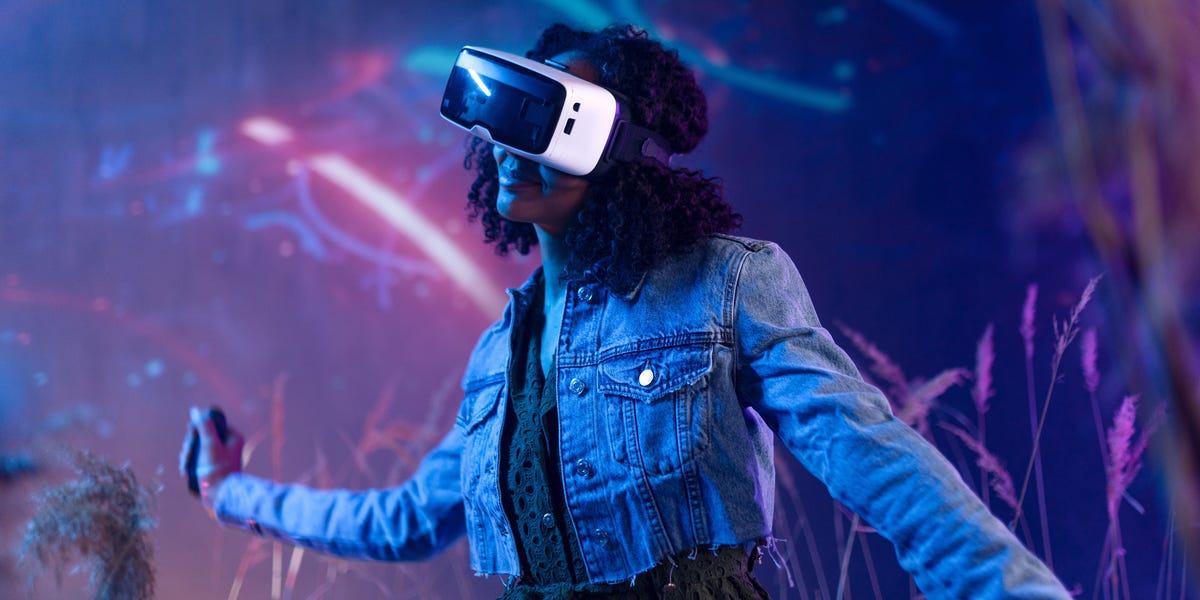- VR concerts have emerged as a creative outlet for artists such as Travis Scott and Teflon Sega.
- Companies like Meta, AmazeVR, and Wave are leaning into the tech, creating hyperrealistic VR performances.
- This article is part of “Build IT,” a series about digital tech and innovation trends that are disrupting industries.
Working in an industry that’s constantly evolving is no small feat for musicians. With changes in trends and music-sharing mediums, artists must keep an ear to the ground to build profitable careers.
Artists’ most lucrative sources of revenue are tour and merchandise sales. In a previous statement to Business Insider, Live Nation said: “Artists make more money from touring than any other piece of their business including recorded, streaming, and more.”
Giving fans a memorable show is crucial, and some artists are looking to virtual reality to do just that. Part of it has to do with the pandemic; shutdowns in 2020 pushed musicians to use different channels to engage with their fans. Travis Scott, for example, partnered with “Fortnite” that year to bring his virtual-reality concert, “Astronomical,” to a global audience. It was successful: Forbes reported that the event drew in 12 million viewers and raked in about $20 million, including from merchandise sales.
But interest in immersive concerts precedes the pandemic. In 2019, the entertainment-technology company Wave launched a multichannel virtual platform for live concerts that could reach fans through various digital means: video games, livestreaming channels, social networks, and more. Wave has since collaborated with the likes of The Weeknd, Justin Bieber, John Legend, Calvin Harris, and Tinashe.
The enigmatic singer Teflon Sega, who performs as a virtual-reality avatar, also worked with Wave to put on a virtual concert in 2022. The artist told BI that he embraced virtual reality — and his digital metaverse persona — after he was dropped by a record label and needed a space to freely share his music.
“A full live performance as an avatar was always something I was excited about but couldn’t wrap my head around how to execute,” he said. “When Wave showed interest in teaming up for a concert series, it was a no-brainer.”
He added: “The market for immersive concerts and live experiences in VR will be a massive shift in the paradigm of performance.”
Why artists and fans are interested in VR concerts
The appeal of VR concerts lies heavily in their experimental nature. Artists can try new ways to express themselves creatively and connect with listeners in digital environments. For fans, skirting painful concert-ticket prices, avoiding large crowds at venues, and experiencing their favorite musicians in an alternate world are convincing perks.
Meta is one of the tech giants that has capitalized on these benefits. In November, Meta Quest launched its Music Valley concert series. The ongoing series has featured virtual performances by artists such as Doja Cat, Blackpink, Victoria Monét, Jack Harlow, and Jorja Smith.
Sarah Malkin, the director of metaverse entertainment content at Meta, told BI that the virtual concerts served both creative and strategic purposes. “Often our VR shows are timed with key artist moments like tour launches or new music drops, helping performers reach their fans across multiple touchpoints and present their music or tour experiences in totally unique ways,” she said.
AmazeVR, an immersive-concert platform that launched in 2015, is another leader in the VR-entertainment space and has partnered with the likes of Sony Music and Roc Nation.
One of its most notable collaborations was with Megan Thee Stallion — the star of AmazeVR’s first VR-concert tour. Over three months, the artist’s VR concert was available to watch at select theaters in different cities. Attendees who purchased tickets went to a designated theater where they were given VR headsets to view the performance.
Steve Lee, the company’s CEO and cofounder, told BI that the debut tour was successful, with it selling out in 15 US cities and allowing consumers to “enjoy the magic of seeing their favorite artist in one of the most realistic forms — proving the power of VR.”
How VR-concert tech works
One of the ways Meta captures VR concerts is by using purpose-built cameras to film artists at their real-life shows.
“We determine the optimal placement of our specialized VR cameras in collaboration with the artists and their teams, integrating our capture system into their shows to provide the best possible viewing experience,” Malkin said.
Meta and the Diamond Bros, a creative-production company, used this approach to film a VR version of Doja Cat’s sold-out Detroit show from her tour last year.
Jason Diamond, the director and executive producer of the Diamond Bros, met with the artist’s team to map out filming. They decided to use a stereoscopic technique, which employs a camera with two lenses that create a 3D effect. Diamond said the triangular stage was “perfect for VR” as it allowed them to give a full view of everything.
At AmazeVR, Lee and his team are developing proprietary technologies to elevate VR music experiences. The company is using visual-effect modules and a custom renderer — used to generate an image from a 2D or 3D model — powered by artificial intelligence and Unreal Engine, a real-time 3D-creation tool. With the help of a top engineering team, the company’s technologies allow it to capture immersive concert footage in 8K resolution, creating sharp visuals.
“These technologies empower us to produce hyperrealistic VR concerts that make attendees feel as though they are face-to-face with the artists,” Lee said.
The downside of VR
VR has its kryptonite. Only about 13% of households in the US own a VR headset, so the technology isn’t ubiquitous. In a survey by Arris Composites, 67% of respondents who didn’t own a VR headset said its hefty price tag kept them from purchasing one, and 33% said they didn’t think they would actually use it.
Some people who paid a pretty penny for an Apple Vision Pro have returned the headset because they simply didn’t know how to set it up or didn’t think the image quality was worth the cost.
Discomfort is another issue: Prolonged headset use could cause neck fatigue and eye strain, and according to the Food and Drug Administration, motion sickness is “the most commonly reported negative side effect” of VR. There’s also the possibility of VR distancing users too far from reality, which could rewire their brains if they don’t moderate headset use.
Where could VR go from here?
Looking ahead, Amy Dorsey, the managing director of Dorsey Pictures, the company that produces Meta’s Red Rocks Live in VR concert series, told BI that developments in extended reality would usher in “the next iteration of entertainment.”
Malkin said she and her Meta team believe those advancements would involve “greater real-time interactivity,” including live avatar engagement between artists and their fans.





